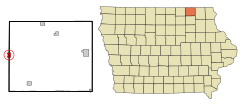Riceville, Iowa facts for kids
Quick facts for kids
Riceville, Iowa
|
|
|---|---|

Location of Riceville, Iowa
|
|
| Country | United States |
| State | Iowa |
| Counties | Mitchell, Howard |
| Area | |
| • Total | 1.07 sq mi (2.76 km2) |
| • Land | 1.06 sq mi (2.74 km2) |
| • Water | 0.01 sq mi (0.02 km2) |
| Elevation | 1,230 ft (375 m) |
| Population
(2020)
|
|
| • Total | 806 |
| • Density | 761.10/sq mi (293.86/km2) |
| Time zone | UTC-6 (Central (CST)) |
| • Summer (DST) | UTC-5 (CDT) |
| ZIP code |
50466
|
| Area code(s) | 641 |
| FIPS code | 19-66585 |
| GNIS feature ID | 0460608 |
Riceville is a small city located in Iowa, a state in the United States. It is found in both Howard and Mitchell counties. In 2020, about 806 people lived there.
Contents
A Look Back: Riceville's History
Riceville was officially started in 1855. Three brothers from the Rice family, Leonard, Dennis, and Gilbert, planned out the town. Later, in 1892, Riceville became an official incorporated town. This means it gained its own local government.
Where is Riceville? Geography and Land
Riceville is located at specific coordinates: 43.362493 degrees North and -92.553461 degrees West. You can find it on a map using these numbers.
The city covers a total area of about 1.11 square miles (2.87 square kilometers). Most of this area, about 1.10 square miles (2.85 square kilometers), is land. A very small part, about 0.01 square miles (0.02 square kilometers), is water.
Who Lives in Riceville? Population Facts
| Historical populations | ||
|---|---|---|
| Year | Pop. | ±% |
| 1900 | 804 | — |
| 1910 | 844 | +5.0% |
| 1920 | 960 | +13.7% |
| 1930 | 807 | −15.9% |
| 1940 | 910 | +12.8% |
| 1950 | 942 | +3.5% |
| 1960 | 898 | −4.7% |
| 1970 | 877 | −2.3% |
| 1980 | 919 | +4.8% |
| 1990 | 827 | −10.0% |
| 2000 | 740 | −10.5% |
| 2010 | 785 | +6.1% |
| 2020 | 806 | +2.7% |
| Source: and Iowa Data Center Source: |
||
The United States government counts how many people live in cities every ten years. This is called a census. Here's what the census found for Riceville in recent years.
The 2020 Census: A Closer Look
In 2020, there were 806 people living in Riceville. These people lived in 351 different homes. About 195 of these homes were families.
The city had about 761 people per square mile. Most of the people living in Riceville were White, making up about 92.3% of the population. Other groups included Native American, Asian, and people from two or more races. About 5.0% of the population identified as Hispanic or Latino.
The average age of people in Riceville was 42.8 years old. About 24.3% of the residents were under 20 years old. Also, 24.7% were 65 years old or older. The population was almost evenly split between males (49.9%) and females (50.1%).
The 2010 Census: What Changed?
In 2010, the census counted 785 people in Riceville. There were 341 homes, with 166 of them being families. The population density was about 714 people per square mile.
Most residents were White (97.7%). Other groups included Native American and people from two or more races. About 2.2% of the population was Hispanic or Latino.
The average age in 2010 was 45.7 years. About 21.9% of residents were under 18. And 25.6% were 65 or older. The city had slightly more females (52.1%) than males (47.9%).
Understanding Population Changes
For a while after the 2010 census, Riceville's population was incorrectly listed as 502. This was a mistake in the paperwork. The correct number of 756 was later confirmed.
How Riceville Makes Money: Local Economy
One interesting business in Riceville is Link Energy. This is a family-run farm that uses a special process called methane digestion. They use animal waste, like manure, and other food waste to create electricity.
This process generates 600 kilowatts of electricity. It also produces biogas, which is a type of fuel. Plus, it makes dairy cattle bedding and a special material called biosolids, which is used as fertilizer for crops.
Famous People from Riceville
Riceville has been home to some notable individuals:
- Jane Elliott: She was an elementary school teacher who created a very famous exercise. This exercise helped people understand what prejudice and racism feel like. She developed it after the death of Martin Luther King Jr..
- John and Larry Dinger: These two brothers made history as the first siblings to both become ambassadors for the United States. They worked their way up in the U.S. Foreign Service.
- Ray Conger: Born and raised in Riceville, Ray Conger was an Olympic athlete. He held world records in running and competed in the 1928 Olympic Games in Amsterdam.
See also
 In Spanish: Riceville (Iowa) para niños
In Spanish: Riceville (Iowa) para niños

